Eggs are considered to be important elements of the dining table around the world. The pros and cons of continuing with diets rich in proteins and cholesterol continue to be debated in many seminars and conferences. Recent years have in particular led to intense discussions on topics related to the role of unsaturated fatty acids in human health and development. While arguing the positive aspects, such discussions often debated the cause of effect of diets on ailments like hypertension, arthritis, autoimmune disorders, inhibition of certain cancers, and the necessity for fatal brain and visual development.
But, so far nobody seems to have concluded. While analyzing the cost-benefit of eggs, Schmier et al. (2009) found out in one study that not taking eggs in diets tends to increase the risk of age-related macular degeneration (ARMD), which in turn might lead to higher healthcare costs. Ensuring the quality of the egg is very crucial for ascertaining that the individual gets desired benefits from the diet. The very basic idea about the quality of an egg comes from taking a physical look at it.
But, an intact egg is one food that does not offer any obvious clues regarding its quality or suitability for consumption. Candling is a method used to make a visual assessment of quality, but accuracy is increased by the measurement of various quality indices of the opened egg.
Eggs have very valuable functional properties that make them suitable in the production of a wide variety of products. Eggs can be utilized in food products for emulsification, foaming, and coagulation purposes. These functional properties are closely linked to the protein components of the various parts of the egg. Ruxton et al (2010) contend that eggs can make a significant contribution to a healthy diet.
In this experiment key properties of eggs have been measured with the help of different measurement techniques like candling, shell quality, and Haugh Index. The functionality of various components of the egg has also been tested.
Measurement of Egg Quality
Test-A: Observation
The physical observation certainly helps in distinguishing good ones and not-so good ones’. In this case while examining two eggs from fresh and stale categories, it was ensured that none of the eggs had cracks on them. But, the fresh ones were physically distinguishable from stale ones in colouring pattern on the surface. While the fresh eggs had no mottling on the surface, the stale ones had few spots of mottling on the surface. In fact this proves to be important criteria in making the distinction.
Test-B: Candling
This is yet another method of physically examining the freshness of egg by holding it against a light. It was observed that while fresh eggs appeared clear during candling, stale one’s were not so clear. There were no spots on the fresh eggs, but the stale eggs had dark red colour spots on the surface. However no rings were found on the surface of both types of eggs during this observation. This might be an indication towards the fact that the stale eggs too were not too old ones’. The candling process also revealed that there were no mottling marks on fresh eggs, but the stale eggs had patches of different colour shades like stains from interior.
Test-C: Egg Density
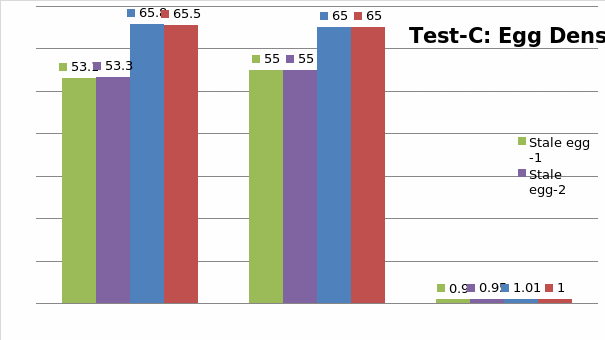
This is an important test to figure out the quality of inside content of the egg. As is evident from the findings, there are variations in the weight of eggs even from the same category.
The protein content varies depending upon several factors including the size of the egg. For example, a medium-sized egg provides 78 kcal, yet contains 6.5 g of protein (Ruxton et al, 2010). Some of the studies also suggest that the feeding programs of pullets also impact egg production in subsequent years. Babiker et al (2010) put great emphasis on the quality of birds at the beginning of her egg production cycle. The profitability of the bird and the venture has been related to the upkeep and quality of the bird.
In this experiment, the difference in weight appears to be similar in fresh as well as in stale eggs. It is worthwhile here to mention that while fresh egg weighed more, the weight of a stale egg was less. This could be because of some liquid content becoming solid during the days the egg was kept in storage. This distinction was apparent in volume as well. While the volume of the fresh egg was found to be 65, the volume of stale eggs was found to be just about 55. The difference in density was however less pronounced in fresh and stale eggs. While the density of fresh egg was around 1 g/ml, it was 0.9-0.95 in the case of stale eggs.
Test D: Yolk Index
Egg yolk is considered of vital importance for the eyes. It contains antioxidant nutrients that accumulate within the macular region of the human retina and support eye function (Burke et al., 2005). There have also been studies pointing out that consuming egg yolk daily for 4-5 weeks leads to an increase in the levels of plasma lutein and zeaxanthin by 50 and 114 percent, respectively (Handelman et al., 1999).
Eggs of hen are generally considered near-perfect food items and a wholesome balanced diet for human consumption. The yolk is the epicenter of this richness in proteins and amino acids. The yolk, duly complemented by the white component is therefore considered as of high biological value and readily digestible.
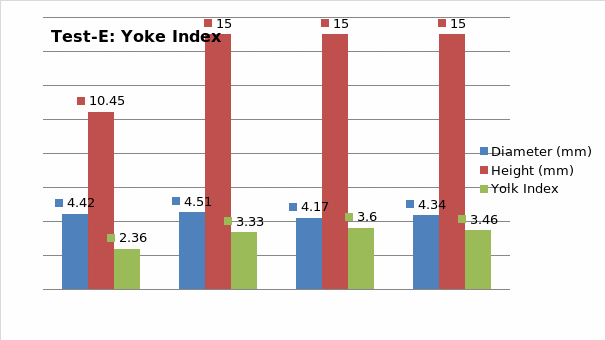
During this experiment vernier calliper and spherometer were used to measure the diameter and height of the egg. While there were differences in the yolk diameters of fresh and stale eggs, no substantial differences were observed in the height. The yolk index however was measured more in the stale eggs.
Waimaleongora-Ek et al (2009) state that the yolk index value calculated as yolk height/yolk width indicates the freshness of eggs. The study has suggested that a decrease in yolk index during the storage process often leads to progressive weakening of the vitelline membranes. Once the membrane becomes weak, it leads to diffusion of water from the albumen. This in turn results in liquefaction of the yolk.
Test-E: Albumin Index
Taking cues from some earlier studies, Waimaleongora-Ek et al (2009) suggest that loss of moisture and carbon dioxide through the shell pores during storage leads to changes in quality of albumen and yolk together with loss of weight of eggs. The study suggests that in order to preserve the ingredients of eggs and maintain the quality the carbon dioxide content and moisture is required to be preserved with the help of a protective barrier.
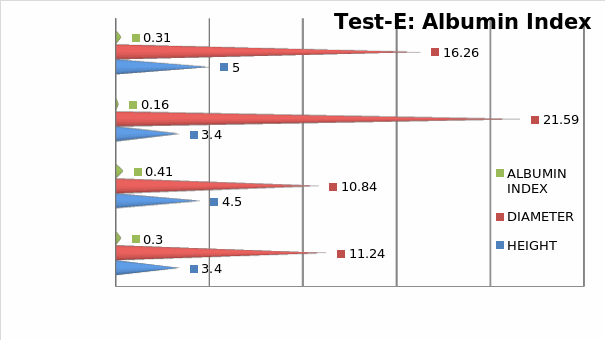
Albumen index is the ratio of height to diameter of the thick white. Therefore, during this test also while measuring the albumin index, the height and diameter of the eggs were taken into account. It is quite apparent from the experiment that the difference in the height and diameter of two types of fresh eggs gets reflected in equal measure in the height and diameter of stale eggs also. The experiment indicates that the albumin index in stale eggs has gone down substantially as compared to the fresh ones.
Test-F: Haugh index
Some of the previous studies suggest that storing eggs with a coat of oil helps in preserving the quality indices like Haugh unit and albumen pH (Waimaleongora-Ek et al, 2009). Haugh unit is measured by relating the weight and height of the thick albumin. A high value of Haugh index, in turn implies better quality of albumen in the eggs. In this experiment while height of thick coat did not indicate wide variations amongst the fresh and stale ones’, there were considerable difference in the weight of eggs. The stale eggs were found to be lesser in weight thus affecting the Haugh index. The value Haugh index in both types of fresh eggs was 89 and 52 respectively but in case of stale eggs this figure varied from 49.48 to 26.
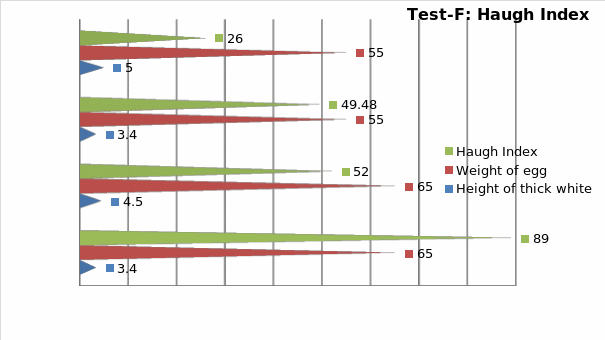
Samli et al. (2005) point out that the storage time and temperature hold strategic significance in impacting the albumin quality or Haugh unit. The difference in the Haugh index in this particular experiment strengthens this hypothesis as the index in stale eggs is less. The index suggested by Raymond Haugh (1937), varies between 20 and 100. A score above 90 is considered excellent, 70 is taken as acceptable while below 60 is rejected as worthless. Therefore, the findings, in this case, indicate that the stale eggs have become worthless as regards their stated properties.
Egg Functionality-Foam
While the external quality of eggs is determined by the shell characteristics, cleanliness, shape, and color the internal quality is determined by the size of the air cell, the muscle tone of white, and the yolk. The evaporation of water content through the shell leads to the impairment of internal quality characteristics. The functionality of eggs includes coagulation, emulsification, and foaming. Foaming is a colloidal suspension with bubbles surrounded by egg albumen. Eggs with larger quantities of globulins display greater foaming abilities (Waimaleongora-Ek, 2009).
In this experiment, the volume of liquid draining was tested with the help of a control sample and subsequently with the help of a sample of 50gms of sugar content. In the control sample, the content was beaten for 6 minutes and 50 seconds with a foam volume of 170. It was beaten until stiff enough to hold the peak but still shiny.
The volume of liquid draining was subsequently checked every 10 minutes for one hour. The readings indicated that in a controlled environment, slightly higher volumes were observed with time, but the variations were little, thus indicating a somewhat linear pattern in the volume of liquid. But, in the case of the sample with 50 gm of sugar, while the volumes of liquid were certainly higher, wider variations were noticed in the volumes during the periodic measurements.
It is believed that the addition of sugar helps in the formation of smooth and stable foam. The hygroscopic nature of sugar helps in providing stability to the foam[1]. Sugar can retard denaturation and coagulation. During this experiment, the sugar-coated foam was beaten for 5 minutes and 2 seconds with a foam volume of 200.
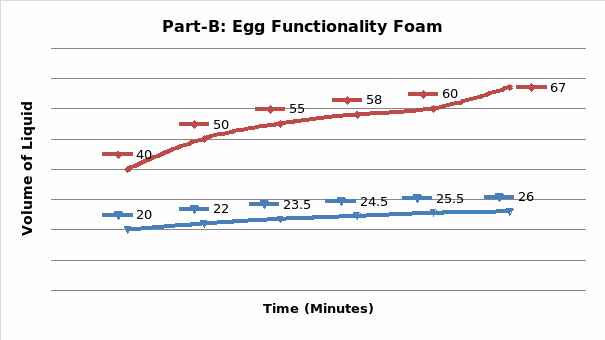
Eggs have been favourite food ingredients owing primarily due to their flavour and functional properties like foaming, thickening and moisturising. These very properties help in preparation of a number of other industrial products and food items derived out of egg. Egg derived packaged food items are comparatively easier to transport than the fresh eggs.
Sample of 120g Reconstituted egg (30g reconstituted egg + 90g of water) to measure the ph and viscosity
The viscosity of egg fluid was tested at different rotational speeds with a pH factor of 7.25. The findings indicate that the apparent viscosity goes high as we reduce the rotational speed. The findings also indicate that while at higher rotational speeds the variations in viscosity are linear, the lower rotational speeds lead to wider variations in the viscosity figures.

Egg Functionality – Cake
It is quite interesting to note that eggs have been classified as nature’s original functional food (Jones, 2007). Therefore its functional attribute hold much significance in the healthcare and food industry. Besides direct consumption, different applications of egg include; liquid mixtures, frozen and dried egg products for use in instant soups, cake mixtures and meat products. Cake is a very popular product using the functionality of egg. In this test we measured the functional properties of fresh, frozen and dried whole egg pulp by using them in preparing standard sponge cakes. The measurements included;
- Cake volume = 500 ml
- Cake height (side) = 2.1 cm
- Cake height (centre) = 5.7 cm
- Nature of the crust: cracky, golden colour, sticky
After cutting,
- Air cell size: tiny, but there are some larger holes
- Air cell distribution: even
- Cell wall thickness: Could not be measured as it was very small
On comparison with the Group-1 formulation it was observed that;
- Colour: was similar to that of group 1
- Texture: was less fluffy and more like sponge than group 1’s
- Moistness: more moist than group 1’s
- Tenderness: Less tender than group 1’s
- Flavour: worse than group 1’s
- Overall acceptability: not bad, but worse than group 1’s
References
- Babiker, M.S; Abbas, S.A; Kijora, C; Danier, J (2010). ‚The Effect of Dietary Protein and Energy Levels During the Growing Period of Egg-type Pullets on Early Egg Production and Egg Weight and Dimensions in Arid Hot Climate’. International Journal of Poultry Science 9(10); 935-943.
- Burke, J.D., Curran-Celentano, J. and Wenzel, A.J. (2005). ‘Diet and serum carotenoid concentrations affect macular pigment optical density in adults 45 years and older’, Journal of Nutrition, Vol. 135 No. 5, pp. 1208-14.
- Egg Foams (n.d.). Web.
- Handelman, G.J., Nightingale, Z.D., Lichtenstein, A.H., Schaefer, E.J. and Blumberg, J.B. (1999), ‘Lutein and zeaxanthin concentrations in plasma after dietary supplementation with egg yolk’, American Journal of Clinical Nutrition, Vol. 70 No. 2, pp. 247-51.
- Jones, D.R (2007). ‘Egg Functionality and Quality during Long-Term Storage’. International Journal of Poultry Science 6 (3): 157-162, 2007. Web.
- Ruxton, C.H.S, Derbyshire, E, Gibson, S (2010). ‚The nutritional properties and health benefits of eggs’. Nutrition & Food Science. Vol. 40 No. 3.
- Samli, H.E., A. Agma and N. Senkoylu. (2005). ‘Effect of storage time and temperature on egg quality in old laying hens’. Journal of Applied Poultry Research. 14: 548-553.
- Schmier, J.K., Barraj, L.M. and Tran, N.L. (2009). ‘Single food focus dietary guidance: lessons learned from an economic analysis of egg consumption’, Cost Effectiveness and Resource Allocation, Vol. 7 No. 1, p. 7.
- Waimaleongora-Ek, Pamarin, Karen M. Garcia, Hong Kyoon No, Witoon Prinyawiwatkul, and Dennis R. Ingram (2009). ‘Selected Quality and Shelf Life of Eggs Coated with Mineral Oil with Different Viscosities’. Vol. 74, Nr. 9. Journal of Food Science. Institute of Food Technologies.